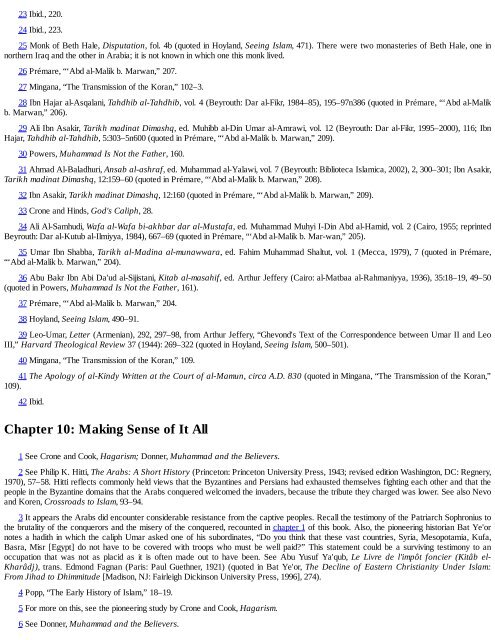robert spencer-did muhammad exist__ an inquiry into islams obscure origins-intercollegiate studies institute (2012) (1)
You also want an ePaper? Increase the reach of your titles
YUMPU automatically turns print PDFs into web optimized ePapers that Google loves.
23 Ibid., 220.<br />
24 Ibid., 223.<br />
25 Monk of Beth Hale, Disputation, fol. 4b (quoted in Hoyl<strong>an</strong>d, Seeing Islam, 471). There were two monasteries of Beth Hale, one in<br />
northern Iraq <strong>an</strong>d the other in Arabia; it is not known in which one this monk lived.<br />
26 Prémare, “‘Abd al-Malik b. Marw<strong>an</strong>,” 207.<br />
27 Ming<strong>an</strong>a, “The Tr<strong>an</strong>smission of the Kor<strong>an</strong>,” 102–3.<br />
28 Ibn Hajar al-Asqal<strong>an</strong>i, Tahdhib al-Tahdhib, vol. 4 (Beyrouth: Dar al-Fikr, 1984–85), 195–97n386 (quoted in Prémare, “‘Abd al-Malik<br />
b. Marw<strong>an</strong>,” 206).<br />
29 Ali Ibn Asakir, Tarikh madinat Dimashq, ed. Muhibb al-Din Umar al-Amrawi, vol. 12 (Beyrouth: Dar al-Fikr, 1995–2000), 116; Ibn<br />
Hajar, Tahdhib al-Tahdhib, 5:303–5n600 (quoted in Prémare, “‘Abd al-Malik b. Marw<strong>an</strong>,” 209).<br />
30 Powers, Muhammad Is Not the Father, 160.<br />
31 Ahmad Al-Baladhuri, Ansab al-ashraf, ed. Muhammad al-Yalawi, vol. 7 (Beyrouth: Biblioteca Islamica, 2002), 2, 300–301; Ibn Asakir,<br />
Tarikh madinat Dimashq, 12:159–60 (quoted in Prémare, “‘Abd al-Malik b. Marw<strong>an</strong>,” 208).<br />
32 Ibn Asakir, Tarikh madinat Dimashq, 12:160 (quoted in Prémare, “‘Abd al-Malik b. Marw<strong>an</strong>,” 209).<br />
33 Crone <strong>an</strong>d Hinds, God's Caliph, 28.<br />
34 Ali Al-Samhudi, Wafa al-Wafa bi-akhbar dar al-Mustafa, ed. Muhammad Muhyi I-Din Abd al-Hamid, vol. 2 (Cairo, 1955; reprinted<br />
Beyrouth: Dar al-Kutub al-Ilmiyya, 1984), 667–69 (quoted in Prémare, “‘Abd al-Malik b. Mar-w<strong>an</strong>,” 205).<br />
35 Umar Ibn Shabba, Tarikh al-Madina al-munawwara, ed. Fahim Muhammad Shaltut, vol. 1 (Mecca, 1979), 7 (quoted in Prémare,<br />
“‘Abd al-Malik b. Marw<strong>an</strong>,” 204).<br />
36 Abu Bakr Ibn Abi Da'ud al-Sijist<strong>an</strong>i, Kitab al-masahif, ed. Arthur Jeffery (Cairo: al-Matbaa al-Rahm<strong>an</strong>iyya, 1936), 35:18–19, 49–50<br />
(quoted in Powers, Muhammad Is Not the Father, 161).<br />
37 Prémare, “‘Abd al-Malik b. Marw<strong>an</strong>,” 204.<br />
38 Hoyl<strong>an</strong>d, Seeing Islam, 490–91.<br />
39 Leo-Umar, Letter (Armeni<strong>an</strong>), 292, 297–98, from Arthur Jeffery, “Ghevond's Text of the Correspondence between Umar II <strong>an</strong>d Leo<br />
III,” Harvard Theological Review 37 (1944): 269–322 (quoted in Hoyl<strong>an</strong>d, Seeing Islam, 500–501).<br />
40 Ming<strong>an</strong>a, “The Tr<strong>an</strong>smission of the Kor<strong>an</strong>,” 109.<br />
41 The Apology of al-Kindy Written at the Court of al-Mamun, circa A.D. 830 (quoted in Ming<strong>an</strong>a, “The Tr<strong>an</strong>smission of the Kor<strong>an</strong>,”<br />
109).<br />
42 Ibid.<br />
Chapter 10: Making Sense of It All<br />
1 See Crone <strong>an</strong>d Cook, Hagarism; Donner, Muhammad <strong>an</strong>d the Believers.<br />
2 See Philip K. Hitti, The Arabs: A Short History (Princeton: Princeton University Press, 1943; revised edition Washington, DC: Regnery,<br />
1970), 57–58. Hitti reflects commonly held views that the Byz<strong>an</strong>tines <strong>an</strong>d Persi<strong>an</strong>s had exhausted themselves fighting each other <strong>an</strong>d that the<br />
people in the Byz<strong>an</strong>tine domains that the Arabs conquered welcomed the invaders, because the tribute they charged was lower. See also Nevo<br />
<strong>an</strong>d Koren, Crossroads to Islam, 93–94.<br />
3 It appears the Arabs <strong>did</strong> encounter considerable resist<strong>an</strong>ce from the captive peoples. Recall the testimony of the Patriarch Sophronius to<br />
the brutality of the conquerors <strong>an</strong>d the misery of the conquered, recounted in chapter 1 of this book. Also, the pioneering histori<strong>an</strong> Bat Ye'or<br />
notes a hadith in which the caliph Umar asked one of his subordinates, “Do you think that these vast countries, Syria, Mesopotamia, Kufa,<br />
Basra, Misr [Egypt] do not have to be covered with troops who must be well paid?” This statement could be a surviving testimony to <strong>an</strong><br />
occupation that was not as placid as it is often made out to have been. See Abu Yusuf Ya'qub, Le Livre de l'impôt foncier (Kitâb el-<br />
Kharâdj), tr<strong>an</strong>s. Edmond Fagn<strong>an</strong> (Paris: Paul Guethner, 1921) (quoted in Bat Ye'or, The Decline of Eastern Christi<strong>an</strong>ity Under Islam:<br />
From Jihad to Dhimmitude [Madison, NJ: Fairleigh Dickinson University Press, 1996], 274).<br />
4 Popp, “The Early History of Islam,” 18–19.<br />
5 For more on this, see the pioneering study by Crone <strong>an</strong>d Cook, Hagarism.<br />
6 See Donner, Muhammad <strong>an</strong>d the Believers.


